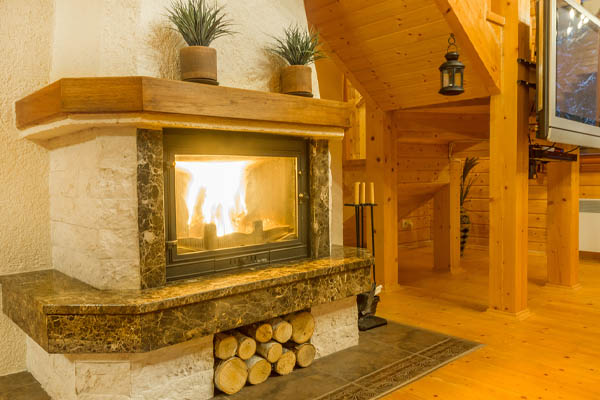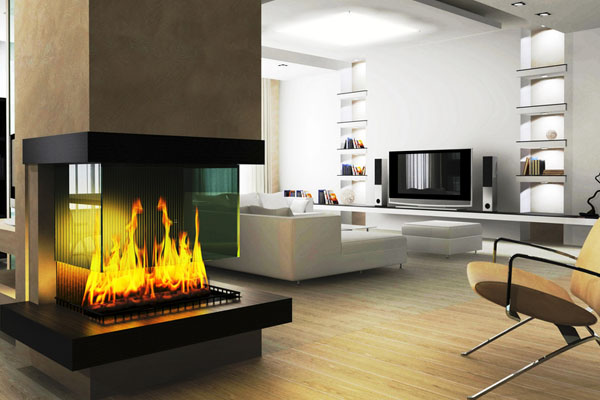Which Is More Efficient, A Fireplace Or Furnace?

Winter is known for freezing temperatures and snow-covered driveways and streets. Thus, you’ll probably wind up spending much of the cold season indoors in an effort to avoid the harsh weather outside. You’ll need a heating solution that can keep your living environment warm, safe, and comfortable without costing a fortune. A lot of homes have both furnaces and fireplaces together. Although both features are compelling, they each have their own drawbacks. One thing that consumers commonly ask is whether a furnace or a fireplace is more efficient for heating the home. This article will compare the fireplace vs furnace efficiency from an objective position.
Furnace vs. Fireplace: Which Option Is the Most Efficient?
When choosing a heating system, energy efficiency is always a top factor considered. After all, the cost of energy and the necessary fuels are soaring throughout the world. Rising inflation and volatile supply chains are major concerns. You want a system that will keep you nice and comfortable without driving you into the poor house. Without this, your home heating plan won’t be a sustainable one.
High-efficiency heating equipment means having a lower carbon footprint as well. If you’re worried about your impact on the natural environment, start focusing on efficiency and efficiency ratings. Some comparisons of heating systems have obvious winners. Others are so close in efficiency that any gap is negligible, which means that other factors can inform your choice.
Wood Fireplaces Are Inefficient, But Aesthetically Beautiful

Fireplaces are classic home features. Humans have been using firewood in their homes for many, many centuries. Wood burning is both simple and effective: you chop the wood you need, arrange your logs in the fireplace, and ignite them. The smoke should rise up and exit the building through the chimney and leave light and warmth behind it. The spectacle of dancing flames is both relaxing and hypnotic. It’s a lovely sight that can have a trance-like effect. Fireplace fires also create an amazing ambiance for household guests, long winter nights, and moments spent relaxing with a hot cup of cocoa. Sadly, aesthetics and mood aren’t the only factors that should inform your decision.
Wood fireplaces have a woefully low rate of efficiency. According to some research, only about a quarter of the heat that’s produced by burning wood actually remains inside the home. The rest rises with the smoke and exits out the chimney. In some instances, the heat can actually be as high as 90 percent. Firewood isn’t cheap. It can definitely be disheartening to know that you’ll pay quite a bit and get so little heat in return. If your budget is a concern, you should look for something that’s more efficient. Gorgeous aesthetics don’t compensate for a lack of efficiency, especially when there are far better ways to heat your home.
Safety is another concern when it comes to using a wood-burning fireplace. Even though they’re in fireplaces, lit fires should never be left unattended. If you plan on stepping out or if you’re going to bed, it’s best to thoroughly douse all of the flames. If you don’t, you won’t be able to stop a fire from spreading if the unexpected occurs. Although the risk of this is fairly low, the potential consequences are huge, and thus, the possibility cannot be ignored. You also have to account for the impact that a fireplace will have on your indoor air quality (IAQ). Even though the vast majority of smoke will be traveling up your chimney, a fair amount of carbon monoxide, ash, carbon dioxide, and volatile organic compounds (VOCs) will remain indoors.
Gas Fireplaces: A Better Choice But Still Lacking

If you like the look and feel that a fireplace provides but don’t want all the hassle, a gas-powered fireplace may be a suitable alternative. You won’t have to burn any wood, and there won’t be any harmful particulates floating through your air. Safety won’t be a big concern. Gas fireplaces are also more convenient, given that there will be a steady supply of fuel to keep the heat flowing. You might not get the charm of popping, crackling wood, but you will get better heat conversion as gas fireplaces have higher efficiency ratings. For most consumers, this trade-off is a welcome one.
Considering the Annual Fuel Utilization Efficiency rating (AFUE), gas fireplaces are at about 70 percent. This is a major rise from the 10% to 20% efficiency that wood-burning fireplaces offer. There are impressive benefits in simply swapping out the heating fuel source. You’ll essentially get more for what you spend, even though you won’t get the best possible returns. Gas furnaces remain miles ahead of gas fireplaces with efficiency ratings as high as 80% to 98%, depending upon which model you choose. If you’re able to get a truly cutting-edge gas furnace, you’ll get superior value.
However, you should remember that a fireplace is only a fireplace. These units are only capable of heating the immediate vicinity. Thus, they work well for heating up a single room like your living room or dent. It may even work well as a heating solution for a small-sized cottage, studio, or shed. However, it won’t do much to heat a standard family home that has two or more floors and multiple rooms. A gas furnace is a far better choice for whole-house heating in this instance.
A Furnace Is Your Best Option
Modern furnaces are reliable and versatile. There are different furnace models and sizes to meet the unique needs of every living environment. These home heating systems use ductwork to distribute the heated air throughout the entire building so that the whole house is warmed up. It won’t offer any dazzling visual spectacles, but it will give you consistent warmth and comfort throughout the cold season. You’ll be able to comfortably move from room to room. Best of all, everyone in your household can sleep soundly in their own beds.
High-efficiency gas furnaces have efficiency ratings as high as 98%. This means that you can reduce your fuel use, keep your monthly heating bills under control, and trump the performance of all other alternatives. A gas furnace is a viable source of heat throughout the entire winter if you need it. The long-term savings that you earn by limiting your fuel use will eventually make up for the higher upfront costs. All in all, this is an investment that can provide excellent returns. Be sure to schedule annual furnace tune-ups for enhanced efficiency, comfort, and more.
Conclusion
Budget-conscious homeowners are easily swayed by head-turning aesthetics. Instead, they consider energy efficiency when choosing between fireplaces and furnaces. This consideration can have a tremendous impact on your carbon footprint, how much energy you use, and your wallet. If you compare the efficiency of different options, you’ll see that gas furnaces handily beat both wood-burning and gas fireplaces in this area. They also provide higher levels of convenience, safety, and IAQ. Make sure to choose a trustworthy HVAC company to perform a scientific load calculation and install your furnace correctly. With the help of qualified professionals, you can enjoy comfortable winters for a very long time.
Call Van Varick & Sons for Your HVAC Needs
Van Varick & Sons offers superior HVAC services in Bergen, Essex, Morris, Passaic, and Sussex counties, New Jersey. You can trust our team of experienced and certified technicians to deliver impressive results in every situation. We specialize in heating and air conditioning repairs, tune-ups, replacements, air quality solutions, and much more.
Van Varick & Sons is proud to offer our customers honest, competitively-priced HVAC service costs. You can count on us to provide you with effective, efficient solutions that fit your budget. Call now to schedule an appointment. We offer free, in-home estimates.
You can click here to contact us now or call us at (973) 694-2777 to find out more! Click the link to view our service area.

